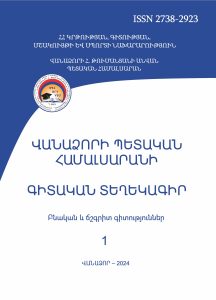The Effect of Different Cultivation Technologies
Scientific Proceedings of Vanadzor State University Natural and Exact Sciences (ISSN 2738-2923)
2024 vol 1
The Effect of Different Cultivation Technologies on the Agromeliorative Condition of the Soil and the Crop Yield of Winter Wheat
Karen Gharakhanyan Meruzhan Galstyan
Summary

Key words: agro-ameliorative property, soil volume, porosity, winter wheat, crop yield
The article represents the results of research on changes in the agromeliorative condition of soil, crop yield, and structural elements of agricultural crops under the influence of various cultivation technologies and equivalent amounts of mineral fertilizers and biohumus.
According to the findings of a two-year study (2021-2023), among the three tested soil cultivation methods (deep plowing 22-25 cm, only loosening 10-12 cm, and no-till), only loosening cultivation proved to be the most effective, which had a more favorable impact on the agromeliorative properties of the soil, contributing to the increased fertility compared to deep plowing and no-till.
Moreover, the research revealed that equivalent amounts of mineral fertilizers and biohumus had uniform effects on the yield of winter wheat and the enhancement of structural elements of the crop under all three soil cultivation methods. However, the highest impact of these fertilizers on agromeliorative properties of the soil, winter wheat yield, and structural elements of the crop was observed only when using the pulverization method. In comparison with other soil cultivation methods, this approach resulted in a wheat yield increase of 3.0-4.0 t/ha or 12.8-14.5 %, recommending its adoption in farming practices.
DOI: https://di.org/10.58726/27382923-ne2024.1-68
